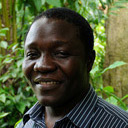Responses to climate change are grouped into two main categories: mitigation (reducing greenhouse gas emissions responsible for climate change) and adaptation (adjusting livelihoods and life styles due to the influences of climate change). Amongst adaptation strategies, ecosystem-based adaptation (EBA) is an approach that promotes ways to use natural resources and biodiversity to help develop adaptation strategies for vulnerable communities. In this context, recent studies highlight the role that the Congo Basin forests play in generating rainfall, both regionally and in the continent as a whole.
Rainfall in an ecosystem originates from three main sources: moisture that is already in the atmosphere, moisture from outside the region, and evapotranspiration from surfaces within the ecosystem (forests and other land uses). Pokam et al. studied how the climate of the Congo Basin is primarily a result of moisture from the Atlantic Ocean and the recycling process of evapotranspiration. Previous studies had established that tropical forests such as the Congo Basin can evaporate up to 1 to 2 meters of water per year. In addition, research by Makarieva et al. suggests that forest cover in the region acts like a pump, moving oceanic moisture towards the continent to eventually become rainfall in that region.
With this role of forests as rainmakers in mind, Nogherotto et al. explored the impacts of deforestation in the Congo Basin on regional hydrological cycles, including the effects on the African monsoon. They modeled scenarios where the Congo Basin is forested versus those in which it is deforested (that is, modeling a situation where forest cover is transformed to short grass cover). Their findings indicate that deforestation in the Congo Basin would lead to modifications in rain behavior in the Sahel and over southern equatorial Africa.
Taken together, these three studies show how the Congo Basin acts as a mechanism for pumping water from the Atlantic Ocean, from underground sources, and from the soil. These sources then mix with atmospheric water, leading to the generation of rainfall both locally and on a sub-continental scale. Without the extensive forests of the Congo Basin, this process would be severely disrupted. In addition, these studies help highlight other important functions of the Congo Basin forests beyond biodiversity conservation and climate change mitigation.
With the growing scientific evidence of the multiple roles that the Congo Basin forests play at regional, continental and global scales, the case for forest conservation, for good forest management, and for multiple income streams to support the forests’ multiple roles becomes stronger. Given their rainmaker role, sustaining the Congo Basin forests might be one of the foundations for EBA to climate change for much of Africa.
Denis Sonwa is a scientist with CIFOR’s Forests and Environment Programme. Denis can be contacted at d.sonwa@cgiar.org
We want you to share Forests News content, which is licensed under Creative Commons Attribution-NonCommercial-ShareAlike 4.0 International (CC BY-NC-SA 4.0). This means you are free to redistribute our material for non-commercial purposes. All we ask is that you give Forests News appropriate credit and link to the original Forests News content, indicate if changes were made, and distribute your contributions under the same Creative Commons license. You must notify Forests News if you repost, reprint or reuse our materials by contacting forestsnews@cifor-icraf.org.





